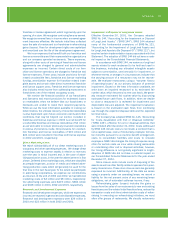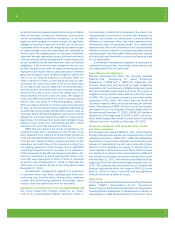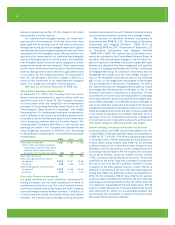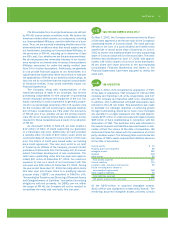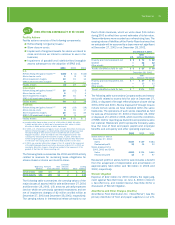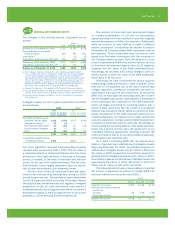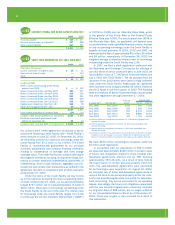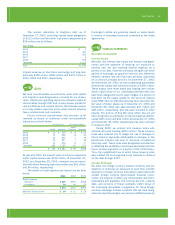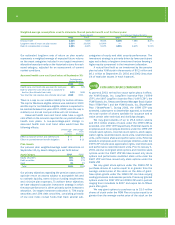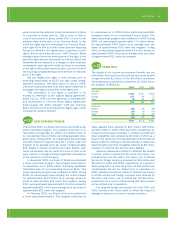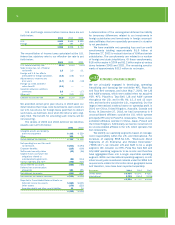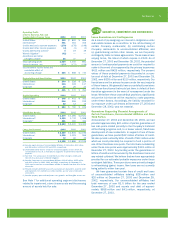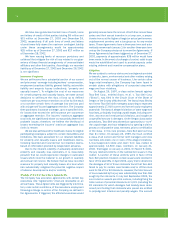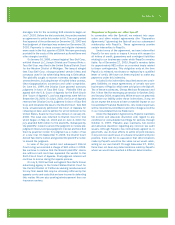Pizza Hut 2003 Annual Report Download - page 65
Download and view the complete annual report
Please find page 65 of the 2003 Pizza Hut annual report below. You can navigate through the pages in the report by either clicking on the pages listed below, or by using the keyword search tool below to find specific information within the annual report.
Yum! Brands Inc. 63.
The annual maturities of long-term debt as of
December 27, 2003, excluding capital lease obligations
of $112 million and derivative instrument adjustments of
$29 million, are as follows:
Year ended:
2004 $ 1
2005 351
2006 202
2007 2
2008 252
Thereafter 1,122
Total $ 1,930
Interest expense on short-term borrowings and long-term
debt was $185 million, $180 million and $172 million in
2003, 2002 and 2001, respectively.
LEASES
note
15
We have non-cancelable commitments under both capital
and long-term operating leases, primarily for our restau-
rants. Capital and operating lease commitments expire at
various dates through 2087 and, in many cases, provide for
rent escalations and renewal options. Most leases require
us to pay related executory costs, which include property
taxes, maintenance and insurance.
Future minimum commitments and amounts to be
received as lessor or sublessor under non-cancelable
leases are set forth below:
Commitments Lease Receivables
Direct
Capital Operating Financing Operating
2004 $ 15 $ 320 $ 8 $ 22
2005 15 290 8 20
2006 14 250 7 19
2007 13 227 7 18
2008 13 204 6 17
Thereafter 122 1,193 63 102
$ 192 $ 2,484 $ 99 $ 198
At year-end 2003, the present value of minimum payments
under capital leases was $112 million. At December 27,
2003, and December 28, 2002, unearned income associ-
ated with direct financing lease receivables was $41 million
and $9 million, respectively.
The details of rental expense and income are set forth
below:
2003 2002 2001
Rental expense
Minimum $ 329 $ 303 $ 268
Contingent 44 40 25
$ 373 $ 343 $ 293
Minimum rental income $ 14 $ 11 $ 14
Contingent rentals are generally based on sales levels
in excess of stipulated amounts contained in the lease
agreements.
FINANCIAL INSTRUMENTS
note
16
Derivative Instruments
Interest Rates
We enter into interest rate swaps and forward rate agree-
ments with the objective of reducing our exposure to
interest rate risk and lowering interest expense for a
portion of our debt. Under the contracts, we agree with other
parties to exchange, at specified intervals, the difference
between variable rate and fixed rate amounts calculated
on a notional principal amount. At December 27, 2003
and December 28, 2002, we had outstanding pay-variable
interest rate swaps with notional amounts of $350 million.
These swaps have reset dates and floating rate indices
which match those of our underlying fixed-rate debt and
have been designated as fair value hedges of a portion of
that debt. As the swaps qualify for the short-cut method
under SFAS 133 no ineffectiveness has been recorded. The
fair value of these swaps as of December 27, 2003 and
December 28, 2002 was approximately $31 million and
$48 million, respectively, and has been included in other
assets. The portion of this fair value which has not yet
been recognized as a reduction to interest expense (approxi-
mately $29 million and $44 million at December 27, 2003
and December 28, 2002, respectively) has been included
in long-term debt.
During 2002, we entered into treasury locks with
notional amounts totaling $250 million. These treasury
locks were entered into to hedge the risk of changes in
future interest payments attributable to changes in the
benchmark interest rate prior to issuance of additional
fixed-rate debt. These locks were designated and effective
in offsetting the variability in cash flows associated with the
future interest payments on a portion of the 2012 Notes.
Thus, the insignificant loss at which these treasury locks
were settled will be recognized as an increase to interest
on the debt through 2012.
Foreign Exchange
We enter into foreign currency forward contracts with the
objective of reducing our exposure to cash flow volatility
arising from foreign currency fluctuations associated with
certain foreign currency denominated financial instru-
ments, the majority of which are intercompany short-term
receivables and payables. The notional amount, maturity
date, and currency of these contracts match those of
the underlying receivables or payables. For those foreign
currency exchange forward contracts that we have desig-
nated as cash flow hedges, we measure ineffectiveness by


